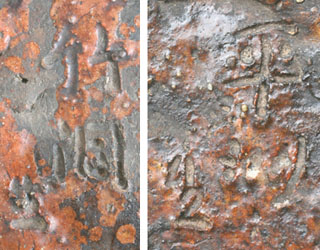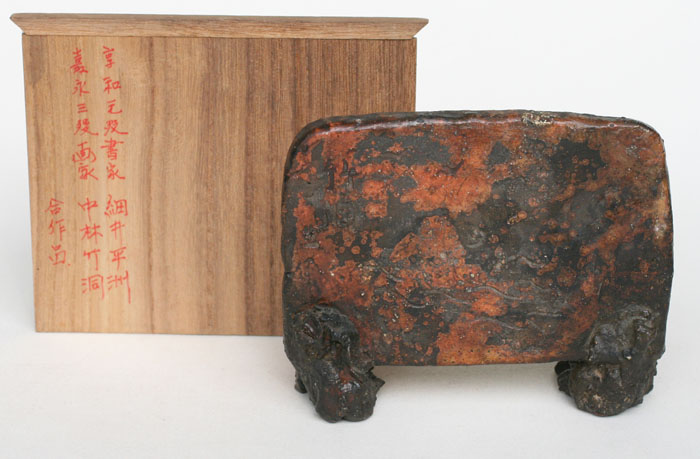 69. Nakabayashi Chikutô (1776-1853) & Hosoi Heishû (1728-1801)
69. Nakabayashi Chikutô (1776-1853) & Hosoi Heishû (1728-1801)Nagna
Rakuyaki kenbyô, Raku inkstone screen carried by lions - Birds, waves and calligraphySigned: Chikutô sei & Heishû sei
Seals:
Technique: Partly glazed Bizenyaki wit incised poem an picture 13,4 x 11 x 5
Box: inscribed
The inscription reads: 姐將煩惱埸、應作女楽園。 平洲生
Young women should turn a place of headaches into a women’s paradise. (HK)
Chikutô is regarded as a theorist of the Nanga School. He was the son of a Nagoya doctor, but at the age of fifteen he became a protégé of the rich collector Kamiya Ten'yû (1721-1801) which gave him the opportunity to study authentic Chinese paintings. Together with his friend Yamamoto Baiitsu (1783-1856), he went to Kyoto in 1802. Moving constantantly between Kyoto and Nagoya he finally settled in his hometown in 1815.
Reference:
Nagoya 2009
Roberts p. 13
Araki p. 645
Kyoto '98 p. 288
Rosenfield ‘99 B.63
Berry & Marioka ‘08 p. 284
Cahill pp. 116-120
Heishû was born in Hirashiyama village, Owari province, into a wealthy family of scholars, who later gave up their status to become farmers.
Heishû was a conservative Confucian teacher, moralist (and misogynist). He delivered his message in an evangelical style of preaching, using colloquial language and drawing from various religious and philosophical traditions. He was compelling speaker, comparable to modern-day television preachers. From 1780 until 1783 Heishû was head of the Confucian academy of his domain. He greatly contributed to a successful program of economic reform in the domain.
Reference:
Roberts. p. 42
Nagasawa # 3926
https://en.wikipedia.org/wiki/Hosoi_Heishu
Price: EUR 1,600 / USD 1,744
